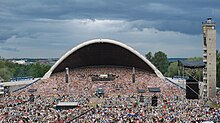The Baltic song festivals (Estonian: laulupidu, Latvian: dziesmu svētki, Lithuanian: dainų šventė) are traditional amateur song and dance festivals in the Baltic States included in the UNESCO Intangible Cultural Heritage List.
| Baltic song and dance celebrations | |
|---|---|
 25th Estonian Song Festival (2009) | |
| Country | Estonia, Latvia, and Lithuania |
| Reference | 00087 |
| Region | Europe and North America |
| Inscription history | |
| Inscription | 2008 (3rd session) |
| List | Representative |
The first song festival was held in Zürich, Switzerland in June 1843. It was attended by 2,184 singers (de:Schweizerisches Gesangsfest).[1] The tradition spread to Würzburg, Germany in 1845, and from there it reached the Baltic States via the Baltic Germans and their choral societies.[2] It was first held in 1869 in Estonia (Estonian Song Festival), and in 1873 in Latvia (Latvian Song and Dance Festival). Lastly, tradition came to the Lithuania (Lithuanian Song Festival) in 1924.[2]
The festivals are massive events, attracting some 30,000 singers. The festivals, held every five years in Estonia and Latvia, and every four years in Lithuania, celebrate traditional folk songs and dances. During the Soviet era, the festivals were a subtle political protest against communism.[3] In the late 1980s, the songs became an integral part of the independence movement, sometimes known as the Singing Revolution. In 2014, the Estonian Song Festival attracted a total of 159,300 people. This was the largest figure recorded since Estonian re-independence.
Festivals
editEstonia
editLatvia
editLithuania
editReferences
edit- ^ Gudelis, Regimantas (2012). "Dainų švenčių ištakos ir liuteroniškoji muzikinė tradicija". Res humanitariae (in Lithuanian). 11: 116. ISSN 1822-7708.
- ^ a b Kasekamp, Andres (2010). A History of the Baltic States. Palgrave Macmillan. p. 95. ISBN 9780230364516.
- ^ Smidchens, Guntis (2014). The Power of Song: Nonviolent National Culture in the Baltic Singing Revolution. University of Washington Press. p. 156. ISBN 9780295804897.